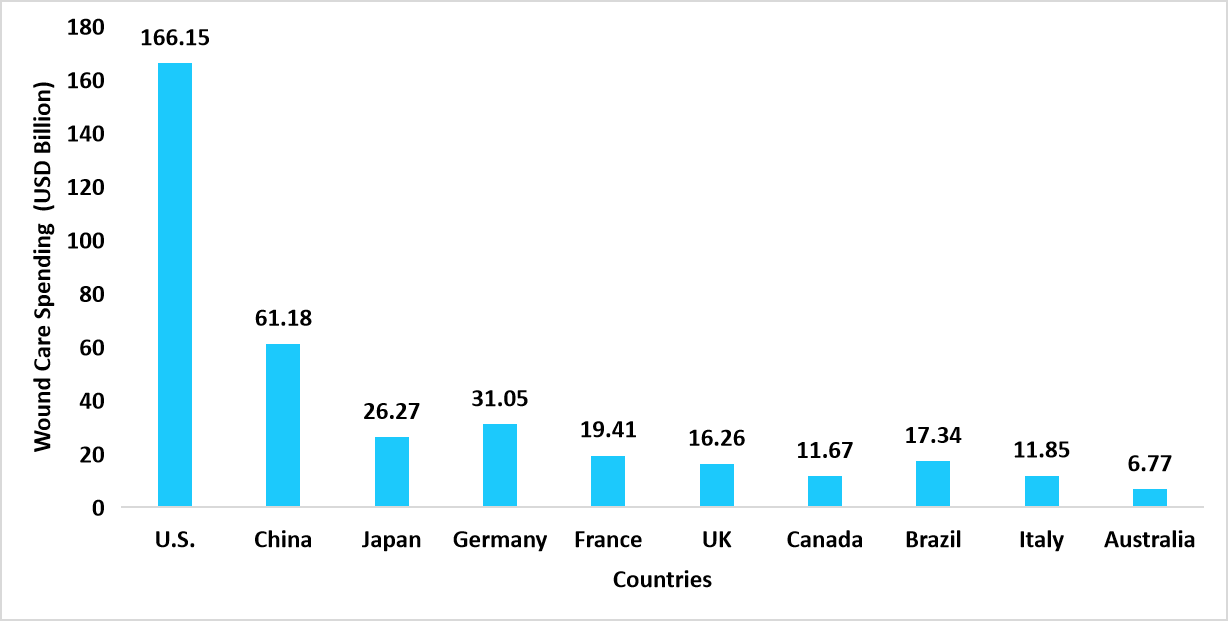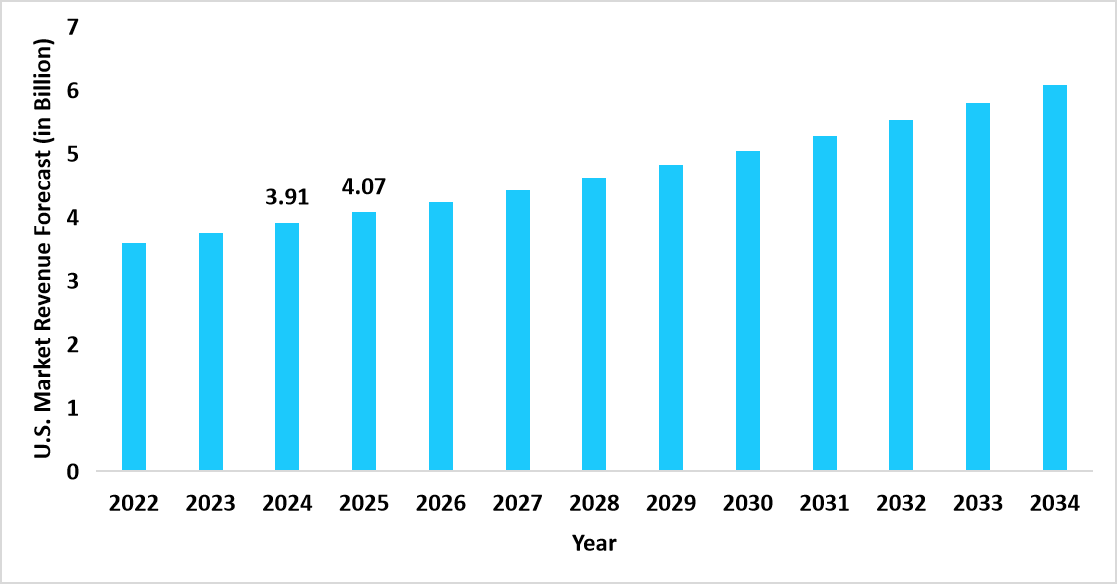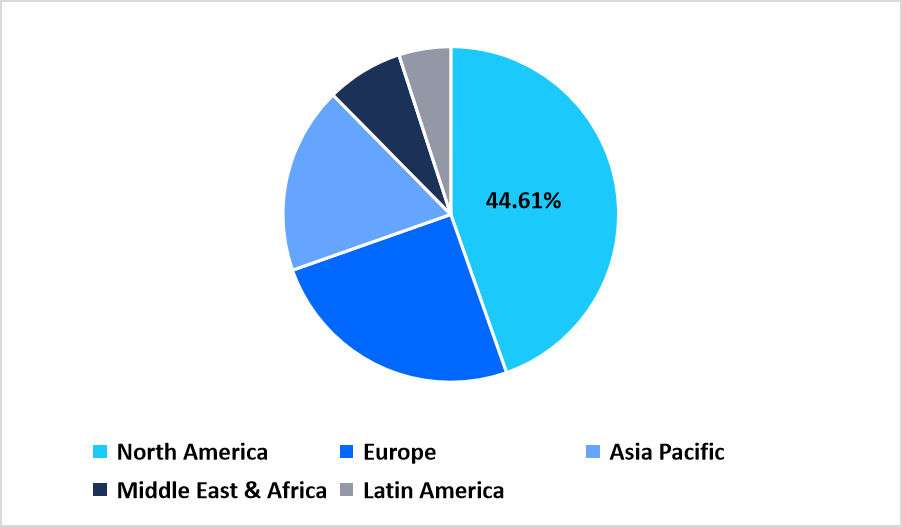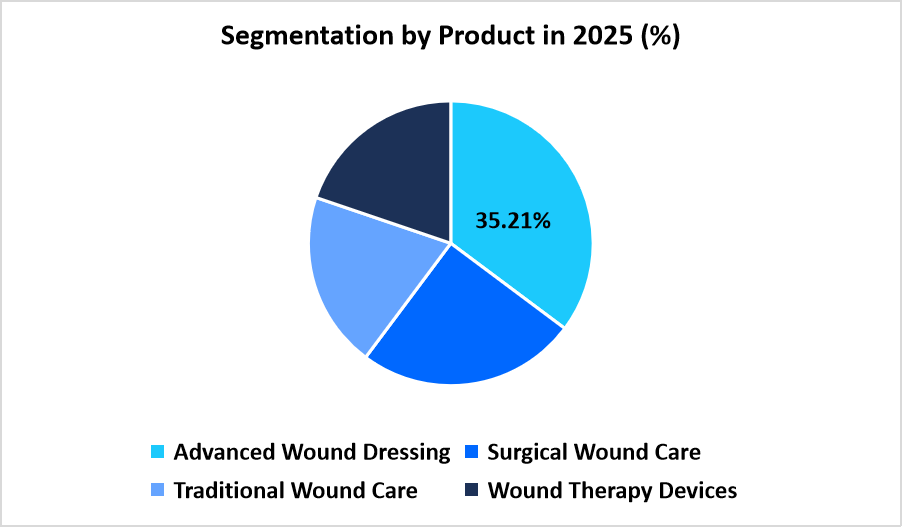Acute Wound Care Market Overview
The global acute wound care market size is estimated at USD 9.87 billion in 2025 and is projected to reach USD 14.73 billion by 2034, growing at a CAGR of 4.59% during the forecast period. Remarkable growth of the market is due to disparity in healthcare spending across major countries, with the U.S. leading at USD 166.15 billion in wound care expenditure, reflecting its strong emphasis on advanced treatment modalities, diagnostic technologies, and comprehensive wound management systems.
Table: Estimated Wound Care Spending in 2024 (USD Billion)

Source: Straits Research
Such distribution highlights that while developed regions dominate in terms of spending, emerging economies are rapidly adopting advanced wound care solutions, contributing to the overall expansion of the global market.
Key Market Trends & Insights
- North America held a dominant share of the global market, accounting for 44.61% share in 2025.
- The Asia Pacific region is growing at the fastest pace, with a CAGR of 6.08%.
- Based on Product, the advanced wound dressings segment dominated the market in 2025 with a revenue share of 35.21%.
- Based on Applications, the burns segment is expected to register the fastest CAGR growth of 4.92%.
- Based on End User, the hospital segment dominated the market in 2025, with the revenue growth of 46.78%.
- The U.S. dominates the global market, valued at USD 3.91 billion in 2024 and reaching USD 4.07 billion in 2025.
Graph: U.S. Market Revenue Forecast (2022 – 2034)

Source: Straits Research
Market Size & Forecast
- 2025 Market Size: USD 9.87 billion
- 2034 Projected Market Size: USD 14.73 billion
- CAGR (2025 to 2034): 4.59%
- Dominating Region: North America
- Fastest-Growing Region: Asia Pacific
The global market comprises a broad range of products and therapies designed to accelerate healing, prevent infections, and improve patient outcomes across various wound types. By product, the market includes advanced wound dressings, surgical wound care, traditional wound care, and wound therapy devices. Advanced wound dressings encompass foam, hydrocolloid, film, alginate, hydrogel, collagen, and other specialized dressings, with foam and hydrocolloid dressings holding a major share due to their effectiveness in managing complex wounds. Surgical wound care includes sutures, staples, tissue adhesives, and sealants, while traditional wound care covers medical tapes, cleansing agents, and other routine products. Wound therapy devices include negative pressure wound therapy systems, oxygen and hyperbaric oxygen equipment, electrical stimulation devices, and pressure relief devices, with negative pressure therapy driving growth due to its efficacy in chronic and acute wounds. By application, the market serves surgical and traumatic wounds as well as burns, with surgical and traumatic wounds representing the largest segment owing to high injury incidence and post-operative care demand. By end-user, acute wound care solutions are employed across hospitals, specialty clinics, and home healthcare settings, with hospitals accounting for the largest share as primary centers for advanced and continuous wound management.
Latest Market Trends
Shift from hospitals towards ambulatory Surgery Centres (ASCs) and Outpatient Care
Healthcare systems worldwide are increasingly moving towards decentralized care, with a growing number of procedures being performed in outpatient settings such as Ambulatory Surgery Centres (ASCs), particularly in the U.S. As per the annual report of Smith + Nephew, the company capitalized on this trend by providing comprehensive solutions tailored for ASCs, including for post-surgical wound care. This shift has been notable in offering cost and time efficiencies for healthcare providers.
Transition Towards AI-Driven Acute Wound Care from Traditional Manual Wound Assessment and Treatment
The acute wound care market is shifting from traditional manual wound assessment and treatment to AI-driven, technology-enabled wound management, which presents as a market trend. According to the medRxiv, the TheraHeal platform it provides a portable, wireless platform integrating a wearable device with an AI Physician that continuously analyzes wound images, diagnoses the wound stage, and prescribes therapies for optimal healing. Such a factor exemplified the growing role of AI and wearable technology in acute wound care, enabling continuous, personalized treatment that improved healing outcomes and enhanced clinical efficiency.

To get more insights about this report Download Free Sample Report
Acute Wound Care Market Driver
Increase in Number of Burn Injuries
The rising number of surgical procedures and traumatic burn injuries is a driver for the acute wound care market. For example, in April 2025, as per the data reported in National Library of Medicine, approximately 500000 individuals in the U.S. suffered from burn injuries annually. Such factor underscored the growing demand for efficient wound care solutions, which further enhances the market growth.
Market Restraint
High Cost of Advanced Wound Care Products
Advanced wound care solutions, including specialized dressings, often come at a higher cost compared to traditional wound care products. Several hospitals in developing countries continue to rely on basic gauze and traditional dressings due to the prohibitive cost of advanced wound care products, despite their clinical benefits. This limited their accessibility, especially in low and middle-income regions or smaller healthcare facilities, thereby restricting market growth.
Market Opportunity
Government Initiative Enhances Wound Care Access in Long-Term Care Homes
Government initiatives are unlocking major opportunities in the acute wound care market by improving access to advanced treatments in long-term care homes. Recently, the Ontario government invested USD 9 million specifically for long-term care homes to purchase diagnostic equipment and train up to 400 staff in skin and wound care treatment. Such targeted programs strengthen wound management in residential facilities, improve patient outcomes, promote adoption of advanced acute wound care technologies, and drive sustainable market growth worldwide.
Regional Analysis
The North America region dominated the market with a revenue share of 44.61% in 2025. The growth is attributed to factors such as the high prevalence of diabetes that leads to chronic wounds, increasing surgical procedures, advanced healthcare infrastructure, strong adoption of advanced wound care technologies, and supportive reimbursement policies that promote access to advanced acute wound management solutions.
The acute wound care market in the U.S. is shaped by Medicare’s dual payment system for long-term care hospitals. Patients with severe wounds receive higher reimbursements only if they meet criteria such as a prior ICU stay. This policy encourages hospitals to adopt cost-efficient, advanced wound care solutions that shorten recovery times and improve patient outcomes.
Asia Pacific Market Insights
The Asia Pacific region is the fastest-growing region with a CAGR of 6.08% during the forecast timeframe. The growth is attributed to factors such as growing cosmetic surgery volumes. Adoption of advanced therapies like NPWT, supportive government reforms, and increasing medical tourism further accelerate market growth.
China’s acute wound care market is growing as the government fast-tracks approval for advanced wound dressings, such as recombinant collagen. In 2023, Winner Medical gained FDA clearance for its collagen products, boosting trust in Chinese transformations. Faster approvals, hospital adoption, and local manufacturing are driving strong wound care market growth.
Pie Chart: Regional Market Share, 2025

Source: Straits Research
Europe Market Insights
The acute wound care market is driven by the recent extension of reimbursement deadlines for wound care products, such as under the German Healthcare Strengthening Act (GVSG). This policy ensures continued coverage, boosting demand and accelerating the growth of the acute wound care market across Europe.
The market in the UK is supported by NHS-guided local formularies that standardize dressing selection and promote evidence-based practice. This ensures consistent adoption of advanced wound care products, reduces clinical variation, improves treatment outcomes, and enhances cost efficiency, thereby driving sustainable market growth.
Middle East and Africa Market Insights
The acute wound care market in the Middle East and Africa is witnessing steady growth due to the rising number of infrastructure investments in advanced healthcare facilities and trauma care centers across the region. Governments in countries such as the UAE, Saudi Arabia, and South Africa are prioritizing the modernization of hospital systems, leading to greater adoption of advanced wound dressing materials, surgical sealants, and negative pressure wound therapy devices.
The market in South Africa is growing rapidly due to the increasing burden of infection-related wounds, which is driving the adoption of specialized wound management solutions. With the country reporting a high prevalence of type 2 diabetes, affecting over 4.5 million adults according to the International Diabetes Federation (IDF), the incidence of acute and chronic wounds such as diabetic foot ulcers has surged.
Latin America Market Insights
The acute wound care market in Latin America is also growing due to the rising adoption of outpatient and ambulatory surgical centers (ASCs), which are increasingly integrating advanced wound management solutions for postoperative recovery. The shift toward minimally invasive surgeries in countries such as Chile, Colombia, and Argentina has created strong demand for compact and easy-to-apply wound dressings, hydrogel-based products, and portable negative pressure wound therapy devices that enable faster discharge and home recovery.
In Argentina, the market is witnessing growth due to the rising awareness and adoption of preventive wound care in chronic disease management. Healthcare providers are increasingly focusing on early intervention for patients with vascular disorders and pressure ulcers to avoid severe complications. Hospitals in Rosario and Mendoza introduced routine screening programs combined with advanced dressings and protective wound care products for high-risk patients. This proactive approach to wound prevention, supported by training programs for clinicians and caregivers, is driving higher adoption of acute wound care products and contributing to overall market expansion in Argentina.
Product Insights
The advanced wound dressings segment dominated the market in 2025 with a revenue share of 35.21%. The growth is attributed to the increasing adoption of advanced dressings that provide a moist healing environment, reduce the risk of infections, and enhance patient comfort.
The wound therapy devices segment is projected to register the fastest CAGR of 5.12% in the global market during the forecast period. This acceleration is primarily driven by the increasing adoption of negative pressure wound therapy (NPWT) systems and oxygen & hyperbaric oxygen equipment, which provide faster healing, reduced infection risk, and improved clinical outcomes in complex and chronic wounds.

Source: Straits Research
Application Insights
The burns segment is anticipated to grow at a CAGR of 4.92% from 2026 - 2034. This growth is attributed to the rising incidence of burn injuries globally, increasing demand for specialized burn care products, and growing awareness of efficient burn management practices in hospitals and home care settings.
The surgical & traumatic wounds dominated the market in 2025, due to the increasing number of surgical procedures and accidental injuries worldwide, which has heightened the demand for efficient and rapid wound management solutions.
End-User Insights
The hospital segment dominated the market in 2025, with a revenue share of 46.78%. The growth is attributed to the high volume of surgical procedures and acute wound cases treated in hospitals, as well as the availability of advanced wound care products across these settings.
The home healthcare is anticipated to register the fastest CAGR of 5.35% due to the advancements in remote monitoring technologies and digital wound management platforms, which have enhanced the quality and safety of home-based care. Integration of smart wound dressings, sensor-based tracking systems, and AI-driven wound assessment tools allows healthcare professionals to remotely evaluate healing progress and adjust treatment protocols in real time.
Competitive Landscape
The global market is highly fragmented in nature due to the presence of numerous established players and a growing number of emerging companies. The top players are Solventum, Smith+Nephew, Coloplast Corp, Medline Industries, Inc., Medtronic, and Others.
Kerecis: An emerging market player
Kerecis is an emerging player in the acute wound care market, focusing on fish skin-based grafts that promote natural healing through the body’s own regenerative processes. Its products are increasingly being used for burns, surgical wounds, and traumatic injuries.
- In September 2025, Kerecis expanded its SurgiClose silicon fish skin product line with new sizes for smaller wounds.
List of key players in Acute Wound Care Market
- Solventum
- Smith + Nephew
- Coloplast Corp
- Medline Industries, Inc.
- Medtronic
- Convatec Group PLC
- Integra LifeSciences Corporation
- Ethicon
- Baxter Regional Medical Center
- Mölnlycke AB
- DeRoyal Industries, Inc.
- Venture Medical LLC
- WoundClear
- Hollister Incorporated
- Winner Medical Co., Ltd.
- Acute Wound Care
- The Wound Company
- MIMEDX Group, Inc
- RestorixHealth
- Organogenesis Inc
- Others

To get more findings about this report Download Market Share
Strategic Initiatives
- November 2024: Geistlich Pharma AG announced its partnership with StimLabs to distribute its advanced wound care product, Derma-Gide, in the U.S.
- April 2024: Smith & Nephew launched new collagen and foam dressings, such as Allevyn Life Foam Dressings to support faster healing of acute wounds in hospitals and home care settings
- April 2024: MTF Biologics and Centurion Therapeutics partnered to expand the access to advance wound care technologies.
Report Scope
| Report Metric | Details |
|---|---|
| Market Size in 2025 | USD 9.87 Billion |
| Market Size in 2026 | USD 10.29 Billion |
| Market Size in 2034 | USD 14.73 Billion |
| CAGR | 4.59% (2026-2034) |
| Base Year for Estimation | 2025 |
| Historical Data | 2022-2024 |
| Forecast Period | 2026-2034 |
| Report Coverage | Revenue Forecast, Competitive Landscape, Growth Factors, Environment & Regulatory Landscape and Trends |
| Segments Covered | By Product, By Application, By End-User, By Region. |
| Geographies Covered | North America, Europe, APAC, Middle East and Africa, LATAM, |
| Countries Covered | U.S., Canada, U.K., Germany, France, Spain, Italy, Russia, Nordic, Benelux, China, Korea, Japan, India, Australia, Taiwan, South East Asia, UAE, Turkey, Saudi Arabia, South Africa, Egypt, Nigeria, Brazil, Mexico, Argentina, Chile, Colombia, |
Explore more data points, trends and opportunities Download Free Sample Report
Acute Wound Care Market Segmentations
By Product (2022-2034)
-
Advanced Wound Dressing
- Foam Dressing
- Hydrocolloid Dressing
- Film Dressing
- Alginate Dressing
- Hydrogel Dressing
- Collagen Dressing
- Other Advanced Dressing.
-
Surgical Wound Care
- Sutures & Staples
- Tissue Adhesive & Sealants
-
Traditional Wound Care
- Medical Tapes
- Cleansing Agents
- Others
-
Wound Therapy Devices
- Negative Pressure Wound Therapy
- Oxygen and Hyperbaric Oxygen Equipment
- Electric Stimulation Devices
- Pressure Relief Devices
By Application (2022-2034)
- Surgical & Traumatic Wounds
- Burns
By End-User (2022-2034)
- Hospitals
- Speciality Clinics
- Home Healthcare
By Region (2022-2034)
- North America
- Europe
- APAC
- Middle East and Africa
- LATAM
Frequently Asked Questions (FAQs)
Debashree Bora
Healthcare Lead
Debashree Bora is a Healthcare Lead with over 7 years of industry experience, specializing in Healthcare IT. She provides comprehensive market insights on digital health, electronic medical records, telehealth, and healthcare analytics. Debashree’s research supports organizations in adopting technology-driven healthcare solutions, improving patient care, and achieving operational efficiency in a rapidly transforming healthcare ecosystem.
Speak To AnalystAvailable for purchase with detailed segment data, forecasts, and regional insights.
Get This ReportOur Clients:










































